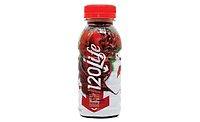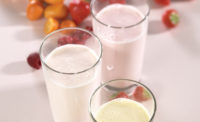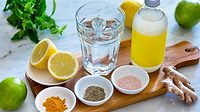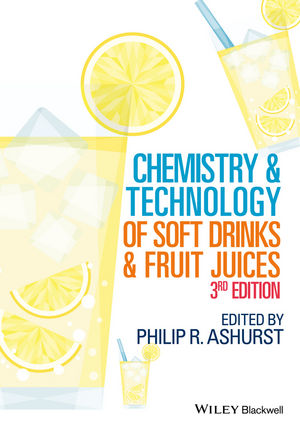In the “Schoolhouse Rock!” episode “The Energy Blues,” an animated globe sang “Sometimes I think I’m runnin’ out of energy.” Although the globe was referring to generating energy for more industrial operations, with the help of vitamins and minerals, beverage-makers have found a solution to consumers’ energy blues.
To help fuel consumers for athletic performance or everyday tasks, manufacturers turn to a number of ingredients.
“Most energy drinks contain a blend of caffeine, taurine and B vitamins to promote a quick energy boost,” says Jeremy Bartos, senior innovation scientist with Glanbia Nutritionals, Carlsbad, Calif. “Amino acids and protein are popular in sports nutrition drink mixes. Sports drinks that focus on hydration are often fortified with electrolytes such as calcium, magnesium and potassium, along with B vitamins and antioxidants.”
Highlighting B vitamins, Watson Inc., West Haven, Conn., offered samples of a Green Apple Granita at this year’s IFT Expo. Fortified with a B-vitamin mix, the premix in the Green Apple Granita can be added to a variety of applications such as energy drinks, carbonated drinks or fruit beverages, the company said.
Cathy Arnold, senior formulation scientist with Fortitech Inc., notes that additional ingredients requested for energy or sports drink formulations include carbohydrates; creatine; l-carnitine; d-ribose; branch chain amino acids such as leucine, isoleucine and valine; n-acetyl-cysteine; and electrolytes such as sodium, potassium, chloride and bicarbonate. GABA and Echinacea also are ingredients she foresees emerging in these categories.
“GABA acts as an inhibitory neurotransmitter in the brain, which may help to prolong time to fatigue and increase glycogen content of muscle,” Arnold says. “GABA has also generated interest in the sports community because it may also influence secretion of growth hormones and thereby influence muscle growth.
“Echinacea is an herbal supplement made from the root or flowers of the Echinacea plant,” she continues. “This herb may have immune-boosting effects and reduce the risk of upper respiratory illness and shorten the duration of infection and may be beneficial to people who may suffer from exercise-induced immunosuppression.”
Ingredient companies also are noticing that, in addition to an energy boost, sustained energy can be viewed as just as important. Cargill, Minneapolis, offers its Xtend Sucromalt, a full-calorie, low-glycemic sweetener that is ideal for use where balanced energy or blunt glucose response is desired.
“With 30 percent of consumers most likely to reach for a beverage for an energy fix, Xtend Sucromalt is a natural fit as a sweetener in sports drinks,” says Melina Montgomery, beverage applications specialist with Cargill. “Seventy percent as sweet as sugar, Xtend Sucromalt offers an opportunity for a reduced-sugar formulation to help beverage manufacturers create on-trend fluid-replacement beverages with the power to both hydrate and energize. For example, we’ve created a couple of prototypes that would appeal to athletes at all levels who are looking for some extra fuel.”
Drinking up the possibilities
The supplement industry continues to thrive. According to the report “Nutritional Supplements in the U.S.” by Rockville, Md.-based Packaged Facts, supplement sales rose 7 percent to $11.5 billion in 2012 and are expected to reach $15.5 billion by 2017.
The report notes that supplement marketers must work to keep their products integral within consumers’ health regimens by highlighting well-publicized ingredients that are backed by science and recognizing the success from functional food competitors.
Citing research by the Nutrition Business Journal, Sam Wright, chief executive officer of The Wright Group, Crowley, La., says that the functional foods category is valued at $41.1 billion and 62 percent of that category is beverages. In comparison, the dietary supplement business surpassed $30 billion in 2011, according to the Nutrition Business Journal.
“This has been a long-term trend favoring more foods and beverages over pills and capsules as a way to achieve better nutritional status,” Wright says. “They are seen as more authentic, which is very important to today’s consumer. From a distribution standpoint, beverages in particular meet the consumer where they are at any given point in the day. Taking dietary supplement [pills] takes a bit more planning, and aging consumers may have problems swallowing the number of tablets [that are] necessary.”
Meeting demands
Although energy is the main functional driver for the energy drink and shot market, consumers want more from these products.
“Enhanced cognition in the form of acuity and focus are two benefits associated with energy drinks [and] shots,” Fortitech’s Arnold says. “They can also help reduce muscle soreness and recovery after exercise but are co-dependent on the energy beverage and the individual’s health, heredity, etc.”
Sports performance also is dealing with increased demands as consumers look for products during workouts as well as pre- and post-workout. To address these mainstream trends, ingredient suppliers are seeing an increased demand for different forms of protein.
“Protein is becoming a very sought-after ingredient and has a broad spectrum of applications across the board in functional beverages,” says Patrick Michael, business development manager with Glanbia. “With our Glanbia Bev-Wise line, we can allow protein to be added to high-acid beverages, low-acid beverages and intermediate beverages that will give the properties sought after by consumers in terms of taste and solubility, allowing the consumers to benefit from the protein and the various attributes they’re seeking to gain from a functional beverage.”
Because of the differing types of consumers for sports performance beverages, manufacturers have a number of different proteins from which to choose.
“Of the various milk-based proteins, you have whey protein for faster digestion and muscle building, with casein proteins more for your endurance-type workouts,” Michael says. “Another emerging protein is soy. In addition to the many benefits of soy, soy is very available and very acceptable by consumers.”
In addition to its various forms for protein, Glanbia also offers amino acids and peptides to support sports nutrition. “When you start getting a little more specific into some of the categories like sports nutrition, body building [and] endurance, the consumers are looking for things that are a little bit more specific as well, which is amino acids and peptides to support muscles, energy [and] muscle recovery, and that’s where our Pepform technology comes into play,” says Shanna Smidt, business development manager with Glanbia. “We have developed what is essentially a carrier for amino acids, and these Pepform peptides are a more soluble solution, so they work very well in beverages to provide a number of different amino acids, such as branch chain amino acids and leucine.”
The Wright Group’s Wright notes that additional ingredients that support post-workout recovery are electrolytes, l-carnitine, phosphatidyl-serine, antioxidants and natural astaxanthin from haematococcus pluvialis algae.
Vitamin E and collagen also are ingredients that can play a role in post-workout beverages, says Kathy Lund, vice president of business development and marketing for AIDP Inc., City of Industry, Calif.
“Vitamin E has antioxidant properties addressing free radicals, and collagen is important for joint recovery,” she says.
But function-based expectations are not the only trends affecting performance beverages. Ingredient companies are sourcing products to help manufacturers develop finished beverages that are accompanied with a natural label claim.
“Consumers are looking for natural sources and cleaner labels,” Glanbia’s Bartos says. “Natural sources of caffeine such as green or black tea, green coffee bean, guarana and other botanicals are being used in place of synthetic caffeine in energy drinks. Artificially flavored beverages are decreasing, making room for energy drinks flavored with tea extracts, stevia, coconut water and juices. The switch toward natural colors that are also biologically functional, such as the anthocyanins, is another impact we’re seeing in the market. Sports nutrition powders are cleaning up their labels, including natural ingredients and innovative protein sources such as hemp, pea and rice protein.”
Glanbia’s Michael notes that although not all beverage segments are concerned about natural or all-natural products, the overall trend continues pushing forward.
“It’s a must moving forward. As the sector of consumers increases, more and more people are looking for cleaner labels,” he says. “We are seeing all the time more and more requests for natural [products] and natural formulations including flavor, sweeteners and, of course, our proteins.”
Additionally, beverage manufacturers are turning to healthful ingredients such as coconut water, juice and tea, ingredient suppliers note.
“Many energy drinks have started using coconut water for hydration and have begun to add protein to help consumers with muscle recovery,” Cargill’s Montgomery says. “We’re also starting to see an increase in energy drinks being formulated with juice or tea to help create unique flavor combinations.”
Formulating solutions
Although function is an important part of performance-based beverages, taste also must be taken into consideration.
“The taste profile for performance beverages is critical to ensure consumer acceptability and repeat purchase,” says Mary Lynn Shafer, beverage strategy and business development manager with Ingredion Inc., Westchester, Ill. “A clean taste profile is ideal given the purpose of the beverage is to support performance, and numerous ingredients come into play here.”
AIDP’s Lund notes that stability, taste and price are typical challenges when working with vitamins, minerals and other functional ingredients.
“Adding functionality to a beverage comes at a cost, which is why many mass products elect to use low price, less functional ingredients,” she says. “However, if the consumer can feel a difference when consuming a beverage, the repeat rate will be high, thereby justifying the additional cost.”
Recognizing issues with shelf life, color stability, ingredient compatibility, solubility, taste, mouthfeel, odor and even clarity, The Wright Group offers SuperCoat microencapsulated ingredients to address challenging ingredient compatibilities for complex formulations, Wright says. He also notes that certification status on genetically modified organisms, kosher and organic ingredients can provide formulation challenges.
Fortitech’s Arnold notes that when developing complex formulations, an important consideration should be the delivery channel.
“Nutrients perform and interact differently depending on how they are integrated and in what application,” she says. “Various market forms may need to be explored, depending upon the end-use. Good practice calls for high-quality nutritional blends that address these issues, which in turn will gain confidence in the product and repeat purchase.” BI
Martin Bauer offers expertise in tea, extracts and botanicals
Martin Bauer Inc., Secaucus, N.J., is one of more than 30 companies worldwide operating under the umbrella of the Martin Bauer Group, a leading global manufacturer and supplier of teas, botanicals and extracts for the food, beverage and dietary supplement industries. A family-owned company in its third generation, with more than 100 years of experience in the world of tea and botanicals, Martin Bauer Group is committed to a consistent quality philosophy based on sustainably grown raw materials and certified production methods. Its extensive portfolio includes herbal raw materials, leaf teas and extracts, which make it an ideal partner for beverage products.
Leaf tea
Its longstanding partnerships in all major tea-growing regions have made it one of the largest tea importers in North America. It offers black, green and white teas from all tea-growing regions in a full range of leaf types and grades.
Tea extracts and tea essences
As a global leader in the production of tea extracts, Martin Bauer can provide customers with a wide range of quality-assured extracts, in liquid or dried form, produced in its state-of-the-art facilities.
Are you looking to enhance the aromatics of your ready-to-drink (RTD) tea? Customers can set themselves apart from the competition by delivering real tea top-notes in their RTD products with Martin Bauer’s new line of water-based tea essences. Made from premium-quality green and black tea leaves, these essences provide an additional boost of tea taste and aroma for a rounder, fuller, better-tasting tea. Black tea extracts are available in a range of brew colors, including a dark extract that is an ideal substitute for caramel color and a great way to make an ingredient line shorter and cleaner.
Its line of all-natural green and black tea extracts delivers authentic tea taste and brings a fuller-bodied tea flavor to both dry mixes and RTD teas. Looking to boost the caffeine content in your tea? Many of Martin Bauer’s tea extracts are standardized, including a green tea extract at 40 percent caffeine.
Botanical extracts
Martin Bauer’s portfolio of botanical extracts includes more than 150 products, from artichoke to valerian. Botanical extracts are versatile and all-natural and deliver a range of exciting tastes and opportunities for innovation. Green coffee extract, guarana, yerba maté and kola nut are ideal for energy drinks and can provide a caffeine boost to juices and teas. Refreshing hibiscus and relaxing chamomile make for great caffeine-free and all-natural alternatives to more generic, artificially flavored fruit drinks. Learn more by visiting the company's website and subscribing to Botanical Horizons, Martin Bauer’s new enewsletter dedicated to botanical ingredients.
Martin Bauer Inc., 300 Harmon Meadow Blvd.,
Suite 510, Secaucus, N.J. 07094; 201/659-3100; martin-bauer-group.us.









